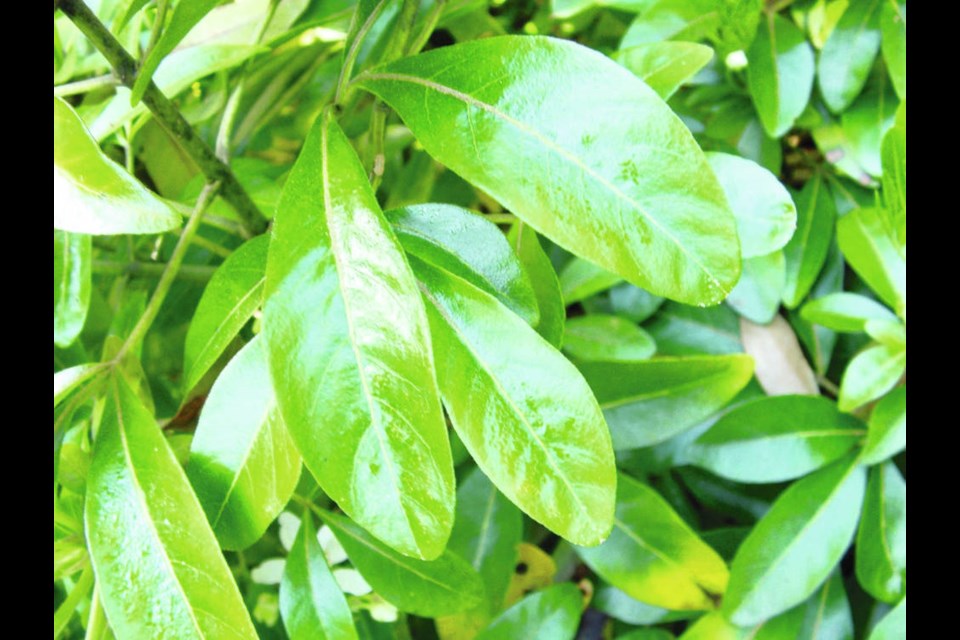Dear Helen: Can you suggest a shrub or perhaps a small tree that would provide some privacy in front of my home’s main door? The site is in full sun. I prefer an evergreen plant, though that’s not a necessity.
S.C.
Your local garden centres will have further ideas for you, but here are two evergreen shrubs for your consideration.
Choisya ternata (Mexican orange blossom) is a handsome, densely mounded shrub with shiny green, aromatic foliage and fragrant white flowers in late spring. There is a golden-leaved form called Sundance. Choisya grows 1.8 to 2.4 metres tall and wide. I once saw a beautiful green Choisya hedge set off with a Sundance plant at both ends.
Ceanothus (California lilac) is a durable shrub often seen in municipal landscape plantings. Victoria is a variety with an upright growth habit. Masses of dark blue flowers appear in the spring and sporadically through the summer. Victoria is recommended for use as a hedge, screen or windbreak. Victoria can grow to three metres high, but the plant responds well to clipping back.
Dear Helen: When is a good time to plant garlic? Should I wait until October or is September all right?
G.A.
The third week in September is ideal for planting garlic, with the preferred, broader planting window being from mid-September to mid-October. Early fall planting gives the bulbs time to develop strong root systems as the soil becomes increasingly cooler through the autumn.
Cold temperatures prompt garlic cloves and bulbs to send out roots. That’s why the bulbs should never be refrigerated.
Dear Helen: One of my carrots is forming what looks like a flower stem. I have never seen that happen before. Is it normal?
L.H.
Carrots, like parsnips, beets, leeks, kale and cabbage, are biennial plants. Biennial vegetables bear their edible crop during the season in which they are planted. In their second year, they produce flowers and then seeds. The flowers usually appear in the spring of the second year and ripen the seed in mid to late summer.
When a biennial vegetable sends up a flower stalk prematurely, in its first year of growth, that is called “bolting.” Bolting tends to occur in some condition of stress, most commonly in high heat, especially when the soil is allowed to dry or is watered irregularly.
It is not unusual for just a few biennial vegetable plants growing in the same bed to bolt into seed-forming mode. Since only one of your carrot plants has done this, there had to be something about that particular seed and plant to render it ultra-sensitive to any stress that might trigger bolting.
Sometimes, these things remain a bit of a mystery. I always wonder why just one or two of my leek plants sends up a flower stalk. Should more than a few carrots, or leeks, or some other biennial vegetable bolt to seed, I would consider the possibility that the variety involved might not be a good fit for my garden’s growing conditions.
Dear Helen: A lovely flower has appeared in my garden. I have no idea what it is. The plant is compact, with hairy leaves and large, single flowers that have broad, burgundy-red centres and bright golden yellow petal tips.
J.C.
Your flower is a Gaillardia (blanket flower) that has somehow seeded itself in your garden.
Most Gaillardia varieties grown in today’s gardens are hybrids, which rarely self-sow. The variety most like your flower is called Goblin, one of the oldest and still most popular single-flowered, bicoloured hybrids. Among open-pollinated (non-hybrid) species, Gaillardia pulchella is most like your flower.
Gaillardia is a drought-tolerant perennial, with a life span commonly limited to between two and four years. The plants are ideal for hot, sunny areas. The compact forms are useful for edging and growing in containers.
You will find Gaillardia plants in some garden centres. As with all highly drought tolerant, sun-loving plants, spring is the best time for planting. Sending newly installed plants with a preference for dryish conditions directly into a rainy season is not a brilliant move.
William Dam Seeds lists Arizona Sun, a compact, bicoloured variety that has merited a Fleuroselect gold medal and also an All-America Selections award. It will flower in its first year from seed. All the Fleuroselect award winning flowers I’ve grown have been superb.
hchesnut@bcsupernet.com



